How often do you have to paint wooden crafts? For example, I never did this until I had a chance to paint the table. The fact is that the wood staining field becomes even more attractive and acquires a lot of useful properties. After I tell you about painting wooden surfaces and products, you will understand that this is a fairly easy process and you can do it yourself.
Choosing the material to be painted
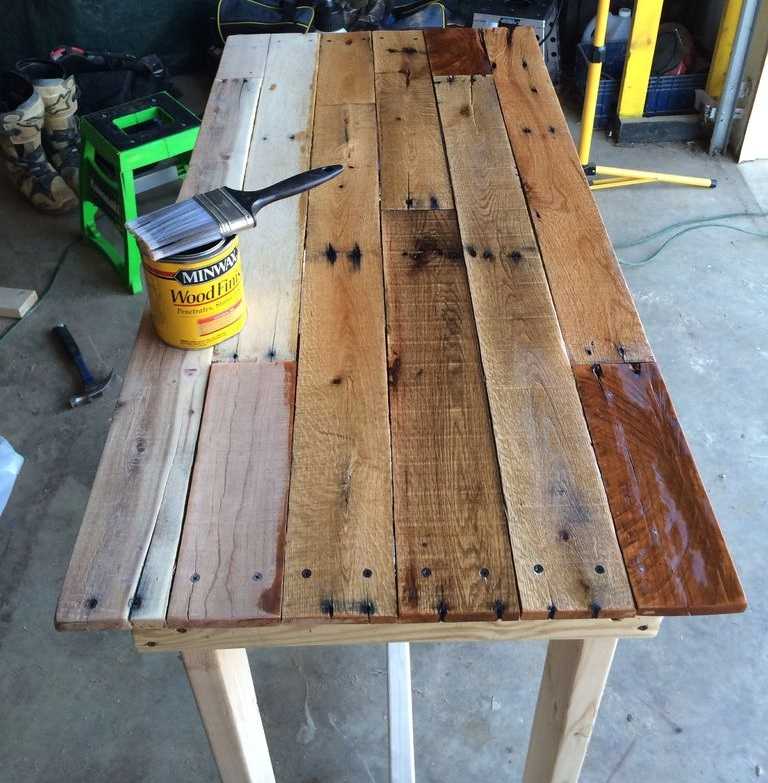
Wood has always been very popular in the manufacture of furniture and interior decoration. But since it is natural material, when painting surfaces, all flaws and flaws can come out. Therefore, it is important here proper preparation products. We will talk about this immediately after we choose the paint we need.
To paint wood, you can use the following materials:
- Lacquer and enamel - almost transparent material which is used to protect surfaces. But even after such staining, wooden products acquire an attractive shade.
- Paint - can completely change the color of the object being painted, but at the same time leave the original wood texture
Table of divisions by composition:
Important! Modern paints are distinguished by their naturalness. More precisely, they are less toxic than varnishes and enamels. That is why use a respirator when painting with such materials.
Impregnation can not only shade wooden elements, but also protect them from the effects of fire. They have antibacterial properties and are often used for woodworking.
We paint the table with our own hands
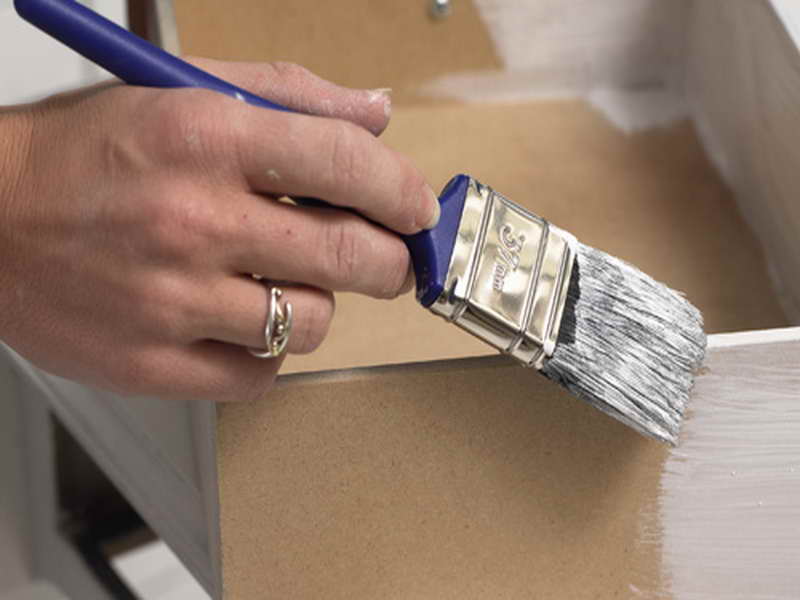
The process of restoring and preparing a table for painting is not as complicated as it might seem. Prepare in advance the tools with which you will remove the old coating from wooden products. Of course, it is better to paint disassembled wooden table, but if you are afraid to damage some parts or it is better not to disassemble it, then it is allowed to paint it like that. The main thing is to make sure that it is stable enough.
The technology of painting surfaces consists in the following sequence:
- The first step is to remove all layers of old varnish or paint. This process needs to be given Special attention, because the quality of the painted wooden product will depend on this. Here we need various washes, a grinder or a building hair dryer
- When the cleaning process is completed, we remove all dirt and grease from the surfaces. Here a solvent comes to the rescue - its low cost allows us not to neglect this procedure.
- If, after removing the paint, the table flaunts with small holes or fallen knots. Then we prime the wood and then putty the right places. We clean the place of finishing and again remove all dust and dirt
- We are waiting for complete drying and only then we apply the substance with which it was planned to paint the table
We select a primer for a specific job
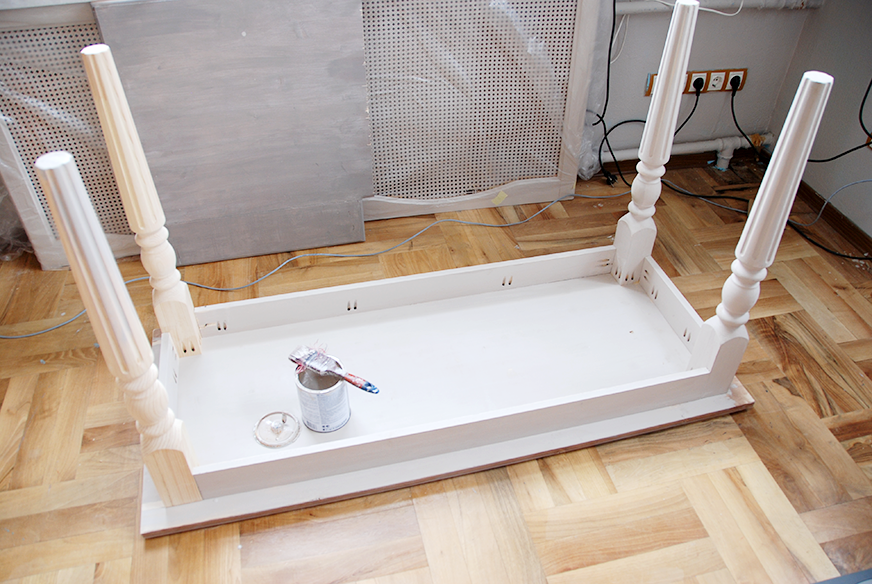
If painting occurs wooden walls or other elements, the choice of primer is also important. Therefore, I decided to compile a table of characteristics of the soils used:
| View | Recommended application | Notes | Full dry time |
| Acrylic water based | It is fashionable to use for any type of wood with the exception of pine and resinous. Works well in tandem with acrylic paints with the same base | Almost odorless and dries very quickly. It is enough to simply treat the surface after priming. Able to stay on previously painted areas | Dries on average in 1 hour, and coloring compositions can be applied after 3-4 hours |
| Alkyd on oil | Used on fresh wood, penetrates deep and isolates resinous knots | Suitable as a base for oil paints. | Dries in 45 minutes, coloring is possible after 7-8 hours |
| Shellac with pigment | It is a blocking of substances penetrating through previous types of soils. If the table is being restored, it helps new paint adhere well to the product | Dries quickly and has almost no bad smell. It is possible to use the material for wooden elements, which are planned to be painted with oil and water mixtures | Drying occurs within 15 minutes, the next layer must be applied after 45 minutes |
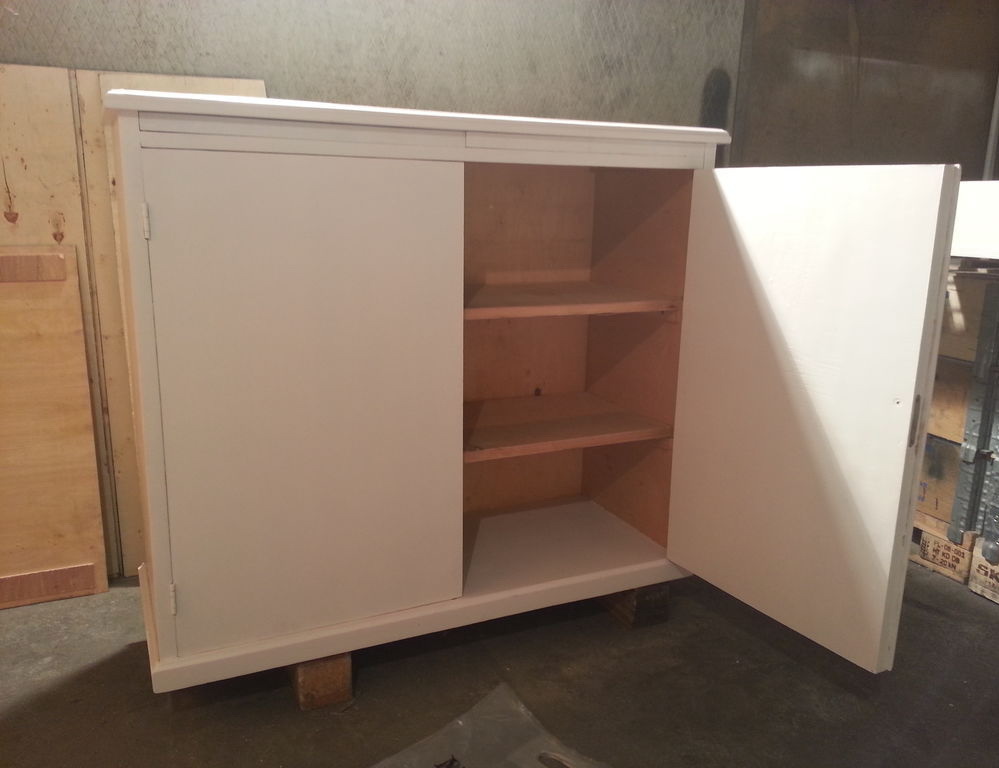
If you need to paint wooden walls, you need to choose the right material. And here it is worth paying attention to such factors:
- What is the purpose of coloring compositions. For external works you can apply oil paint, it will perfectly protect the walls from the harmful effects. Mixes on acrylic base they help protect just as well, but they also have a much higher price than their predecessor
- Inside the house for wooden walls, it is better to use water-dispersion mixtures. Their advantage is fast drying and no smell.
- To keep natural wood flooring apply stain and varnish
- The amount of material required depends on how the paint spreads. Most often, manufacturers indicate everything on the packaging, and the application technology is prescribed there. But it's often better to consult a professional.
- Painting materials are made for different weather, and each has its own temperature threshold required for application or quality service. Look at the markings that are on the packages and ask for their decoding from sellers in hardware stores
Painting technology wooden materials does not differ from other painted places. For this process, you can use the following tools:
- Brush - a narrow and wide brush will help you both paint large areas and reach hard-to-reach places
- Roller - for it you still need to purchase a brush. It is she who will help paint those places where the roller will be helpless. By the way, he still needs some skill
- Sponge - suitable for craftsmen and professionals. If the painting of wooden elements is done by a beginner, then it is better for him to use other tools.
- Atomizer - it will be very easy and simple to complete all processes with it. With such a tool, all work will go quickly and smoothly. The gun does not leave streaks and does not scatter in different directions as with brushes. This not only allows you to stay clean, but also saves on material.
As auxiliary tools for painting, you need to purchase paint trays, gloves and protective mask for face. Be sure to cover all furniture that may be exposed to coloring elements. Do-it-yourself painting will not be any problem if you are serious about the preparatory process.
In this article, we will look at how to properly paint a tree. On the one hand, the implementation of such a task may seem very simple.
On the other hand, if you want to achieve an ideal result, you will need impeccable performance. step by step instructions. So let's get started.
Painting work
Before painting a wooden surface, it must be properly prepared, because the paint itself is not able to repair cracks, dents, chips and possible holes. The picture will come out good only if a high-quality canvas is used, and in our case, the base to be processed should have an appropriate appearance.
The instruction looks like this:
Action package No. 1: wood preparation
You will need the following tools:
- Remove the maximum old paint metal spatula.
Tip: if the previous coverage was carried out oil paint, it is recommended to pre-treat it with hot air from an industrial hair dryer. The paint layer will swell and peel off as a result, making it easier to remove.
- What could not be torn off is treated with trisodium phosphate, which at the same time will clean the wood from dirt.
- Rinse the surface with water.
- After the tree dries, we close up all existing cracks, chips and scratches. If there are significant defects or even through holes, then to eliminate them we use a special putty, which is better not to save in such cases.
- After the putty material has hardened, we sand along the wood fibers using sandpaper grit 80-100 grit, which allows you to eliminate the last remnants of the old layer of paint and level.
- Then we go over the wood with a finer sandpaper with a grit of 150 grit to smooth the surface for applying the primer.
- We remove the remains of large debris with a dry rag.
Tip: if you have a vacuum cleaner on hand, it is better to remove all debris with it, it will be more effective.
- Then we go over the wood with a damp cloth to eliminate small grains that can interfere with the quality application of the primer and paint.
- We seal the areas that we want to leave unpainted with special adhesive tape for paintwork materials, which can be purchased at any specialized store. It is noteworthy that if you want to paint the glued areas in a different color in the future, and not just leave them intact, then you should close them after priming.
- Apply the primer in several layers. For dark rocks wood we use gray solutions, for light - white. Sometimes the owners neglect this step, considering priming only an extra waste of time and money.
This is fundamentally wrong, since the soil cover performs several important tasks:
For application, you can use a brush or spray, let's compare the effectiveness of these two tools:
Set of actions number 2: applying paint
First of all, you should decide on the question, what is the best way to paint a tree? Indeed, today in specialized stores you can find big choice paintwork materials.
The main types of paints for wood are as follows:
- Acrylic.
Their composition is based on ordinary water and acrylates, due to which they have many advantages:
- Operational safety. This option leads the types of wood paints for internal works, since in the process of solidification it emits only water vapor, which is absolutely harmless.
- High strength and durability. After drying, a reliable polymer layer remains.
- A wide range of colors. In addition, you can easily mix the shade you need.
- Ease of application. Such a dye for wood lays down evenly and without smudges.
- Possibility of partial tinting.
- Alkyd. If you are considering types of paints for exterior woodwork, then this option will be very interesting, as it has increased water-repellent properties, excellent frost resistance, which allows it to endure a drop in temperature environment down to -30 degrees Celsius, and low cost.
But there are also disadvantages:
- Relatively short service life.
- The need for a dry base. Can wet wood be painted with alkyd mortar? No, which makes it possible to use them only in dry, clear weather.
- Toxicity. Not recommended for indoor use.
- Oily. An outdated version that has many negative aspects, including high cost, toxicity and a tendency to crack.
You can also use natural dyes for wood, which only emphasize its natural texture and give a peculiar shade.
Now let's move on to the painting itself:
- Dip the brush into the paint can, rotate it 180 degrees and dip it again so that the solution is evenly distributed on both sides of the bristles.
- We apply a layer on the wood from top to bottom, without delaying the pause between strokes.
- Then we take a clean brush and dotted fill the corners of the surface, which eliminates the appearance of smudges.
- After complete drying of the coating, apply a second layer.
Conclusion
Painting a tree is not difficult, but you must adhere to certain rules and carefully prepare it.
The video in this article will provide additional information. Good luck painting!
Wood is great construction material, which has excellent strength, reliability, long service life. A timber house needs special care and protection against aging, exposure to precipitation, frost, destruction by microorganisms and insects.
Linseed oil is used to prevent further rot formation.
What paint is better to paint a house made of wood? It is necessary to choose such a paint for wooden house, which would prevent the destruction of the material from negative external influences.
Preparing the wood surface for painting
Before starting work on painting a wooden house, it is necessary to prepare the surface. It is necessary to carry out preparatory work that will improve the adhesion of the dye to the wood and increase its performance, increase its durability.
Materials and tools:
- sprayer;
- brush;
- putty knife;
- antiseptic;
- primer;
- film.
First you need to clean the wood from dust and dirt with a sprayer and brush. If mold is found, it is eliminated with an antiseptic. If resin appears, it is removed with a spatula, and then the place where it was formed is painted with varnish. small metal objects: screws, self-tapping screws are treated with a primer for metal. After graduation preparatory work the tree is covered with foil and left for 2 weeks. In the film, you need to make several holes for the passage of air.
Back to index
How to paint a tree
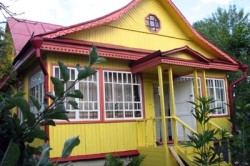
Oil paint will protect from atmospheric negativity.
What paint to paint wooden house? Currently, there are 3 types of coatings that can be used to paint a wooden house:
- antiseptics;
- acrylate paints;
- oil paints.
Antiseptics have excellent adhesion to the surface. They penetrate into the wood layer by 5-6 mm. Thanks to this, the tree receives protection from adverse atmospheric influences, microorganisms, insects.
Glazing antiseptics are transparent, so they can be used as a finish. They do not paint over the texture of wood, emphasize its natural color. The service life of wood treated with this coating reaches 7 years.
Acrylic paints are highly resistant to aggressive external influences.
They retain color and gloss for a long time. They allow the wood to breathe, protect it from damage and cracking. The durability of the coating, painted with acrylate dye, is more than 10 years.
Oil paints are resistant to precipitation, frost, and other negative natural influences. They absorb great. After application, they should dry within a day. They may lose their color over time. The durability of the coating is about 6 years.
Back to index
Applying paint to a new wood surface
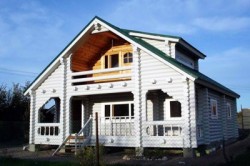
To prevent further formation of rot, it is best to use acrylate paints.
Materials and tools:
- dye;
- primer;
- brush;
- primer color.
What else is important to know when answering the question of what paint to paint a wooden house with? First of all, it is necessary to apply an antiseptic primer to the tree to protect it from microorganisms. This event will increase the life of the wood. After that, paint is applied. Dry wood should be painted. The dye is applied in three layers. After applying each layer, it must dry well. When painting, it is necessary to mix the paint regularly so that its color is uniform. Coloring is done with a brush, then the layer will be uniform. If it is necessary to achieve a higher quality of staining, then a primer color is used.
It is desirable to carry out painting work on a wooden house in warm weather in the absence of strong wind and scorching sunlight. Staining is carried out in the longitudinal direction. The ends of a wooden house must be processed especially carefully. They are applied with several layers of primer and dye. Painting the house is done from top to bottom, moving from one area to another. This ensures uniform application of the dye.
The selection of compositions for coloring wood should be made taking into account a number of important factors. A competent choice of paint will guarantee the long-term operation of wood products and structures.
Types of coatings for wood - how are they chosen, what are they?
The tree is one of the best materials for the construction of private houses, finishing works inside residential premises, the manufacture of various pieces of furniture and products used in everyday life. Natural wood has a chic appearance, is environmentally friendly, it breathes and perfectly saves heat. The lifespan of any wooden structures and surfaces directly depends on how well and correctly they will be treated with special paints and varnishes (LKM). The latter must be chosen taking into account:
- Types of wood used. Painting structures from coniferous tree performed by some compositions, from hardwood - by others.
- Possibilities of reprocessing a wooden product painted with a specific paintwork material.
- Operating conditions of buildings and surfaces made of wood (high humidity, exposure to sunlight, and so on).
- Compatibility of the selected paint with coatings, primers applied earlier.
- Methods of preparing products for dyeing.
As you can see, figuring out how to paint a tree is not so simple. There are many for sale now. various types LKM. They are divided into three main groups - transparent compositions, dispersion coatings, opaque enamels. Under the first understand all kinds of impregnations, protective special glazes and varnishes without color. Transparent coatings are used to protect wood from ultraviolet radiation and emphasize the natural wood structure.
Dispersion compositions provide increased water and frost resistance, vapor permeability of processed products, as well as the preservation of the color of the latter for a long time. The solvent for such coatings is water, and the binder is alkyd resins, acrylates or synthetic latexes. The most famous representative of dispersion coatings - acrylic paint. She is very popular these days. Opaque enamels are traditional coloring compositions. They are characterized by ease of use, good hydrophobic properties, guarantee high quality processing.
In everyday life, wood painting is most often done with alkyd, oil and acrylic compounds. We will talk about the features of these colors in more detail.
Oil compositions - slowly go into oblivion
Oil based paints last years are used less and less. Their main producers are domestic companies. Foreign companies practically do not produce such paints. Drying oil is present in oil mixtures. This additive makes paints toxic and odorless.

Working with oil compositions is not very convenient. Firstly, they are applied exclusively in cool and absolutely dry weather. If a little rain drips outside, the staining process will have to be postponed. Secondly, these paints dry for at least a day. Thirdly, before applying the oil mixture, you will have to work hard on the preparation wooden surface. It should be thoroughly cleaned and leveled. If you don't do this, you will get a poorly painted surface with streaks, bubbles and other defects.
Despite the fact that wood is now being actively replaced by plastic, metal or drywall, given material still used in many apartments and houses. We must also not forget that some decorative elements made of wood look much more aesthetically pleasing than their counterparts made from substitutes. However, unlike many substitutes, wood wears out quickly and requires repair and painting. In order not to spend money on a craftsman, you can independently do the work of restoring a wooden product, you just need to study the material below.
To paint wood products, we need:
- Paint for wood;
- set of brushes;
- high-quality putty primer;
- building hair dryer or chemicals for surface cleaning;
- sanding pad.
How to paint wood:

- The first thing to do is to buy quality paint for a tree. Now it can be purchased both in specialized stores and in large supermarkets. If you cannot choose the right paint and varnish products yourself, then take a picture of the coating and ask the consultant to choose the type of paint and shade.
The universal product in this case is oil enamel, it can be used to paint any type of wood, it is often treated with rough parts of the product due to its good resistance to damage.
If you only want to spend a little redecorating products, then you will probably need acrylic enamel, which is much cheaper than oil, but they cannot withstand water and are more prone to wear. Them positive properties fast drying and the possibility of coating any type of wood.
Varnished products will have an excellent appearance. For these needs, you can use oil varnishes with increased wear resistance or polyurethane, which are famous for their high drying speed.
- Now you need to prepare a set of tools. First, choose a brush of the right size for painting the product. If the product consists of many small elements, then you need to choose the appropriate set of brushes. Surface polishing will be done with sandpaper.
- Before applying paint to wood, you need to clean the surface. To do this, remove the remaining layers of old paint, which can be done with building hair dryer, which will heat the paint and make it liquid, after which you will only have to remove it from the surface with a spatula. If you do not have the opportunity to get a building hair dryer, then you can use a chemical preparation that burns out any enamel or varnish without any problems. After using chemicals, the remaining reagents are washed off with vinegar and plain water. In extreme cases, to remove the old coating, you can use a regular sandpaper and, at the end of the work, remove the dust that has formed from the working surface.
- It is not uncommon for the surface to be carefully sanded. Such a need arises if the surface has noticeable defects, scratches or holes. Try to putty the surface as gently as possible so that you do not have to fiddle with it for a long time, it is better to use the smallest brush for this work. Check the evenness of the surface before it hardens, because after it it will be much more difficult to level.
- To seal large defects, use building foam, when the foam hardens, cut off excess material with a regular knife. Small irregularities can be corrected with a skin. It is recommended to cover the putty with drying oil, which will protect it from cracks during painting.
- You can protect the surface and improve the result of work by additionally covering the product with a high-quality primer. This technique is especially necessary if the product has irregularities. The primer allows you to increase the service life of the product and reduce paint consumption. It will be enough only one layer and two hours of drying so that the surface can be considered primed.
- You can proceed directly to painting, for this, draw straight vertical lines with a brush, after each such line, lower the brush into the paint. Make sure the paint runs evenly.
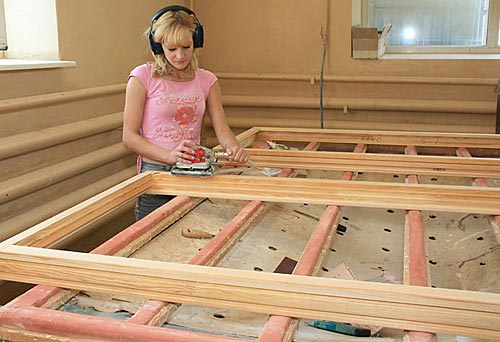
To protect your health, wear a respirator and rubber gloves. greatest danger for health represents the use of building hair dryer or chemicals. Try to start work early in the morning with good natural light.